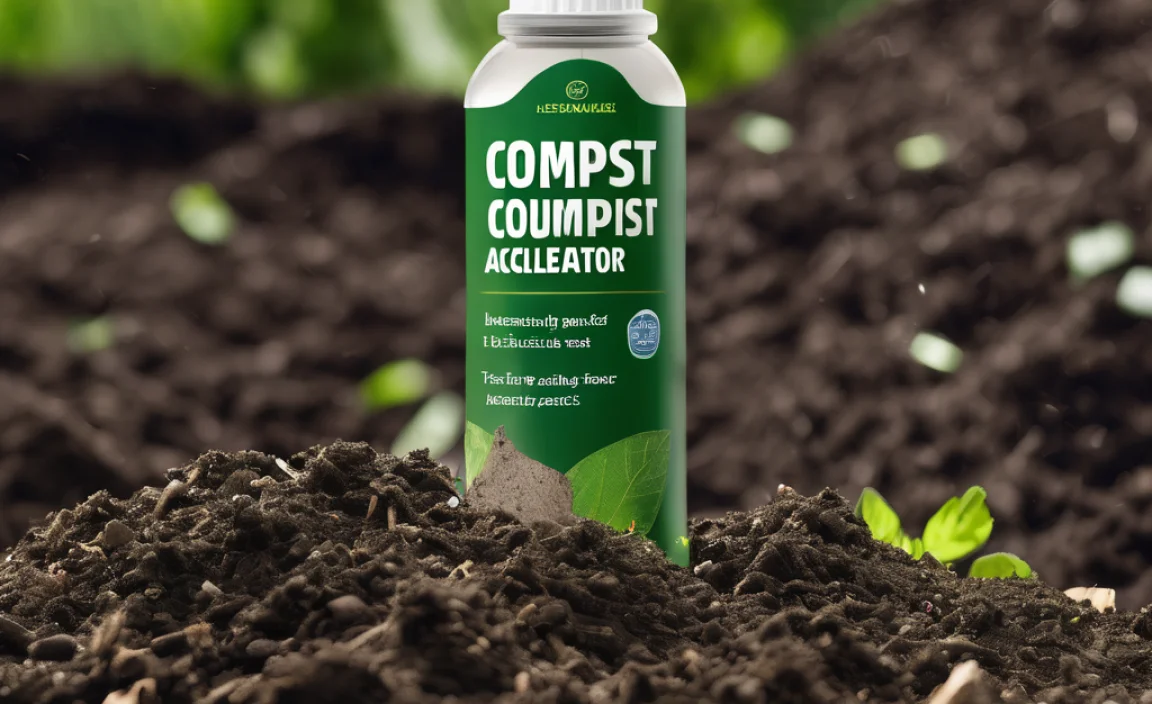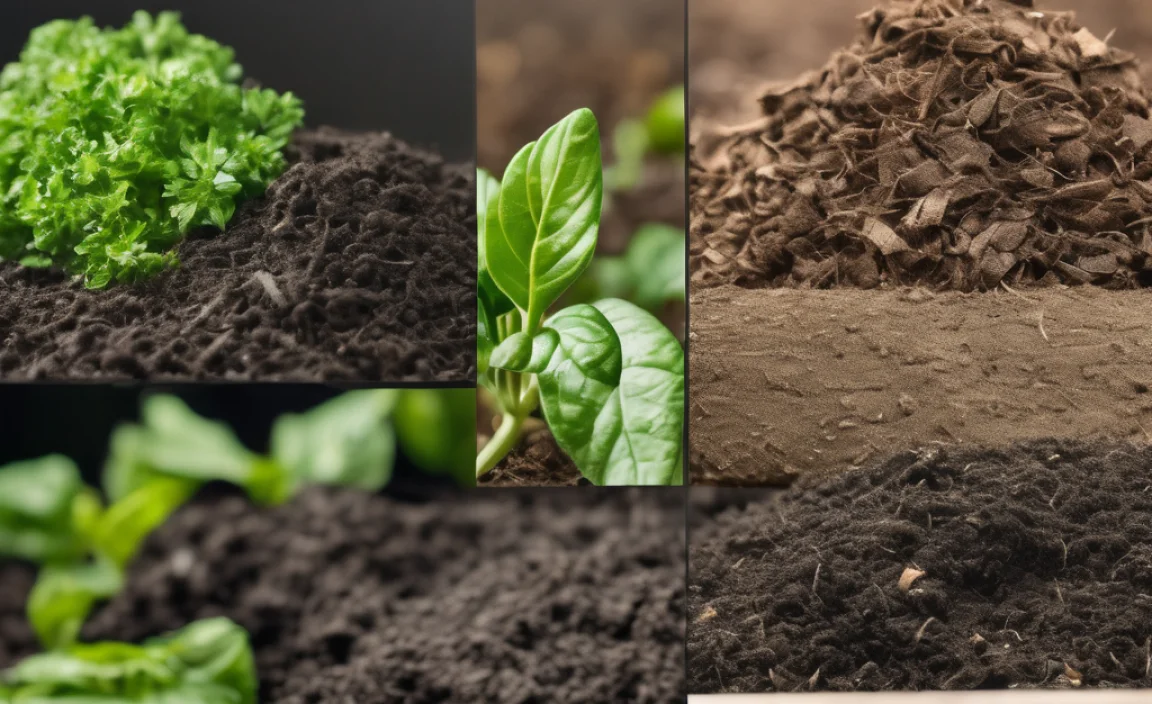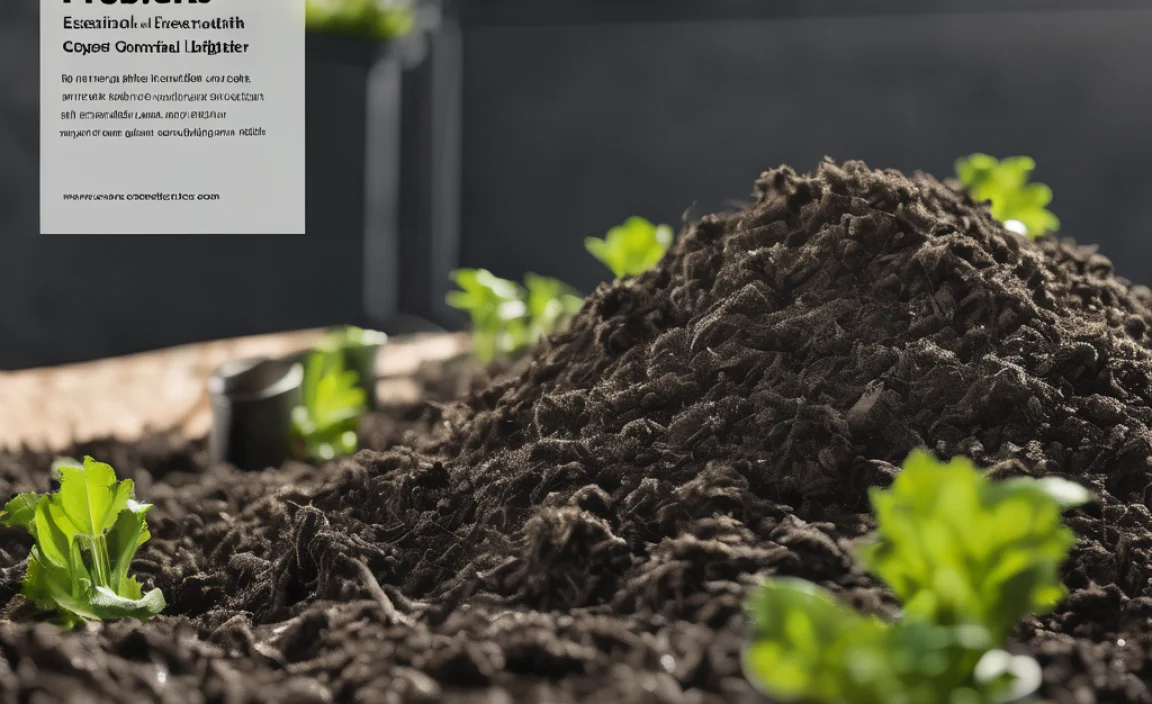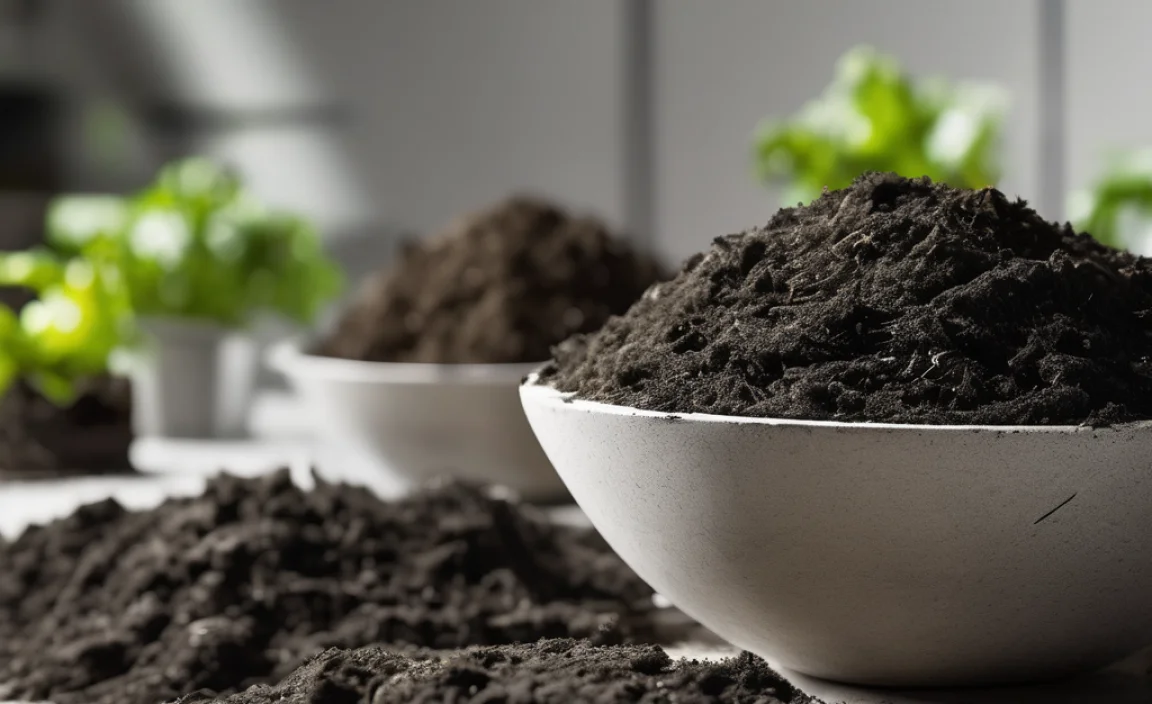So, you’ve jumped into composting, which is fantastic! You’re turning kitchen scraps and yard waste into garden gold. But maybe you’re using a compost accelerator and things aren’t speeding up like you hoped. You might see your pile looking the same, smelling a bit off, or just not getting that warm, cozy feeling of decomposition happening. It’s a common hiccup, and it can be frustrating when you’re eager to start using your compost. Don’t worry, though! We’re going to break down the usual suspects that cause these problems and, more importantly, give you simple, actionable solutions. You’ve got this!
What Exactly is a Compost Accelerator?

Before we tackle the problems, let’s quickly chat about what these accelerat0rs are meant to do. Think of them as a little energy boost for your compost pile. They usually contain beneficial microbes, enzymes, or nutrients that help break down the organic material faster. The goal is to get your compost pile humming with activity, heating up, and decomposing in weeks rather than months. They’re not magic potions, but they can certainly give your hardworking compost critters a helping hand.
Common Compost Accelerator Problems & Their Solutions

Even with the best intentions and a helpful accelerator, things can sometimes go sideways. Here are the most common issues you might encounter and how to fix them:
1. Compost Pile Isn’t Heating Up
This is a big one! A hot compost pile is a sign of active decomposition. If your pile is cool, it’s likely a sign that something is out of balance. The accelerator might not be enough on its own to jumpstart the process if other critical elements are missing.
Why it Might Be Happening:
- Improper Carbon-to-Nitrogen Ratio: Your pile needs a good mix of ‘greens’ (nitrogen-rich, like food scraps and grass clippings) and ‘browns’ (carbon-rich, like dry leaves, shredded paper, and twigs). Too much of one or the other can slow things down. A common mistake is having too many browns and not enough greens, or vice-versa.
- Not Enough Moisture: The microbes that break down your compost need a damp environment, like a wrung-out sponge. If it’s too dry, they can’t do their work efficiently.
- Poor Aeration (Not Enough Air): Compost needs oxygen! Without it, decomposition happens anaerobically, which is much slower and can lead to stinky compost.
- Pile is Too Small: A compost pile needs a certain mass to build up heat effectively. Small piles, like those in a small bin with only a few scraps, might not have enough material to get hot.
- Cold Weather: While compost can still work in cooler temperatures, it will definitely slow down. Accelerators can struggle to get a pile hot in freezing conditions.
How to Fix It:
- Adjust the Ratio: Aim for roughly a 2:1 or 3:1 ratio of browns to greens (by volume). If your pile is too brown, add more nitrogen-rich materials. If it’s too green (and smells ammonia-like), add more carbon materials.
- Add More Water: Lightly water the dry parts of your pile. Turn the pile to ensure the moisture is distributed evenly.
- Aerate Your Pile: Turn your compost pile regularly. Aim to turn it at least once every week or two. You can use a pitchfork or a compost aerator tool. For tumblers, just spin them!
- Build a Bigger Pile: If your pile is too small, add more materials. A minimum size of about 3x3x3 feet is often recommended for hot composting.
- Be Patient in Cold Weather: In winter, expect slower decomposition. You can insulate your pile with straw or use a compost blanket to help retain heat.
- Check the Accelerator: Ensure you’re using the accelerator according to the package directions. Some require mixing with water first.
2. Unpleasant Odors (Rotten Egg or Ammonia Smell)
A healthy compost pile should smell earthy and pleasant. If it smells like rotten eggs or strong ammonia, it’s a sign of anaerobic conditions or an imbalance of materials. Your compost predator friends are probably unhappy!
Why it Might Be Happening:
- Too Much Nitrogen (Ammonia Smell): This happens when you have an excess of ‘green’ materials like grass clippings, coffee grounds, or kitchen scraps without enough ‘brown’ materials to balance them.
- Anaerobic Decomposition (Rotten Egg Smell): This occurs when there’s not enough air circulating in the pile, leading to decomposition by bacteria that don’t need oxygen. This often happens in compacted, waterlogged piles.
- Too Much Moisture: A soggy pile prevents air from getting in, creating those stinky anaerobic conditions.
How to Fix It:
- Balance with Browns: If you smell ammonia, immediately turn your pile and add a generous layer of carbon-rich browns (dry leaves, straw, shredded cardboard or paper). This will absorb the excess nitrogen and help introduce air.
- Aerate Thoroughly: Turn your pile diligently. If it’s compacted, break up any large clumps. Aim to incorporate air into the center of the pile, as this is often where it’s lacking.
- Reduce Moisture: If the pile is too wet, add dry brown materials. You can also try to cover the pile to prevent excess rain from soaking it. For very wet piles, you might need to dig it out, spread it to dry for a day, and then rebuild it with a good mix of greens and browns.
- Check Accelerator Usage: Ensure you haven’t over-applied the accelerator; sometimes, too much of a good thing can disrupt the natural balance.
3. Pests (Flies, Rodents, etc.)
No one wants unwelcome guests in their compost. Pests are usually attracted by exposed food or an unbalanced pile.
Why it Might Be Happening:
- Exposed Food Scraps: Fruit and vegetable scraps can be very attractive to flies and other small critters.
- Meat, Dairy, or Oily Foods: These items are particularly appealing to rodents and can also cause foul odors, attracting other pests. Most compost accelerators and guides recommend avoiding these.
- Pile is Too Wet or Too Dry: Extreme moisture levels can sometimes attract certain pests.
- Open-Top Bins or Piles: These offer easy access for larger animals.
How to Fix It:
- Bury Food Scraps: Always bury fresh kitchen scraps deep within the pile, covering them with a layer of browns. This helps deter flies and masks odors.
- Avoid Problematic Items: Stick to compostable materials. As a general rule for most home composters, avoid meat, bones, dairy products, oily foods, and diseased plants. For more detailed guidance, consider resources from university extension offices like those found at University of Minnesota Extension.
- Maintain Proper Moisture: Ensure the pile is damp, not soggy or dusty.
- Cover Your Pile: Use a compost bin with a lid, or if you have an open pile, cover it with a tarp or a layer of straw.
- Add More Browns: A good layer of browns can often help mask attractants and make the pile less appealing to pests.
- Use a Compost Tumbler: Tumblers are great for deterring pests because they are enclosed and often have smaller openings.
4. Accelerator Not Working Effectively
You’ve followed the directions, added the accelerator, but it just feels like nothing is happening. It might not be the accelerator’s fault alone.
Why it Might Be Happening:
- Incorrect Application: Maybe it wasn’t mixed properly with water, or it was applied unevenly.
- Expired Product: Like any product with microbes, accelerators can lose their potency over time.
- Pile Conditions Not Suitable: The accelerator needs a good environment to work. If the moisture, aeration, or carbon-to-nitrogen balance is off, the microbes in the accelerator will struggle.
- Using the Wrong Type of Accelerator: Some accelerators are designed for specific composting methods (e.g., hot composting vs. cold composting) or for particular types of materials.
How to Fix It:
- Follow Instructions Precisely: Read the accelerator’s label carefully. Some need to be mixed with water and allowed to sit for a bit before application.
- Check Expiration Date: If the product is old, it might be time to get a new one. Store accelerators in a cool, dry place.
- Create Ideal Conditions: Focus on getting your pile’s moisture, aeration, and C:N ratio right. The accelerator works best as a “booster” in a healthy system, not as a fix for fundamental flaws.
- Choose Wisely: Ensure the accelerator you’re using is appropriate for your composting setup and goals.
5. Compost is Too Slimy or Clumped
A desirable compost pile is loose and airy. If yours is turning into a slimy, clumpy mess, it’s a clear sign of too much moisture and lack of air.
Why it Might Be Happening:
- Excess Moisture: This is the primary culprit, leading to compaction and anaerobic conditions.
- Too Many ‘Green’ Materials: Nitrogen-rich materials tend to be wet and can contribute to sliminess if not balanced with browns.
- Lack of Aeration: The organic matter doesn’t have room to breathe, leading to clumping.
How to Fix It:
- Incorporate Dry Browns: Add plenty of carbon-rich materials like shredded paper, cardboard, straw, or dry leaves. These act like sponges, absorbing excess moisture and adding bulk for aeration.
- Turn and Fluff: Break up large clumps with a pitchfork or shovel. Try to get air into every part of the pile.
- Reduce Water Usage: If you’ve been adding a lot of water, cut back until the pile feels like a damp sponge.
- Consider a Compost Bin with Drainage: If you’re in a very wet climate, a bin that allows for good drainage can be very helpful.
Understanding the Ingredients of Your Accelerator

While most accelerators are designed to be safe and effective, knowing what’s inside can help you troubleshoot. Common ingredients include:
| Ingredient Type | What It Does | Potential Issues if Imbalanced |
|---|---|---|
| Beneficial Microbes (Bacteria, Fungi) |
Kick-start and speed up the decomposition process by consuming organic matter. | Can die off if conditions (moisture, temperature, pH) are too extreme. |
| Enzymes | Break down complex organic molecules into simpler ones that microbes can consume more easily. | Less effective if the pile isn’t in the right conditions for the microbes to thrive. |
| Nutrients (Nitrogen Sources) | Provide essential elements for microbial growth and activity. | Can upset the carbon-to-nitrogen ratio if added in excess, leading to ammonia smells. |
| Minerals (e.g., Lime, Rock Phosphate) | Can help balance pH and provide trace minerals. | Too much lime can make the pile too alkaline, hindering some microbial activity. |
It’s important to remember that a compost accelerator is a supplement, not a replacement for the fundamental principles of good composting. For a successful compost pile, you still need to manage moisture, aeration, and the balance of green and brown materials.
Troubleshooting Table: A Quick Reference

Here’s a handy table to quickly pinpoint your compost problem and its most likely solution. Think of it as your compost cheat sheet!
| Problem | Likely Cause | Primary Solution |
|---|---|---|
| Pile isn’t heating up | Imbalanced C:N ratio, too dry, poor aeration, pile too small | Adjust C:N ratio, add water, aerate pile, build to at least 3x3x3 ft |
| Strong foul odors (ammonia or rotten eggs) | Too much nitrogen (ammonia), lack of air/too wet (rotten eggs) | Add browns, aerate thoroughly, reduce moisture |
| Attracting pests (flies, rodents) | Exposed food scraps, meat/dairy/oils, open pile | Bury food scraps, avoid meats/dairy, use a bin with a lid, add browns |
| Accelerator seems ineffective | Incorrect application, expired product, poor pile conditions | Follow instructions, check expiry, improve pile environment |
| Compost is slimy and clumpy | Too much moisture, too many greens, poor aeration | Add dry browns, aerate, reduce watering, ensure drainage |
| Pile is very slow to decompose overall | Lack of moisture, lack of air, wrong C:N ratio, cold weather | Add water, aerate, adjust C:N ratio, insulate pile in cold |
When to Consider a New Accelerator

If you’ve tried all the troubleshooting steps for your pile and still aren’t seeing results, it might be time to re-evaluate your compost accelerator. Here’s when it might be the product itself:
- Expired Product: Check the “best by” date on the packaging. Microbe-based products have a shelf life.
- Improper Storage: If the accelerator was stored in extreme heat or cold, or left open, its effectiveness could be compromised.
- Inconsistent Results: If you’ve used the same accelerator for a while with good results, but suddenly things have changed, there might be a batch issue or it’s past its prime.
- No Visible Difference: Even with a properly balanced pile, a good accelerator should show some signs of activity or at least contribute to faster breakdown. If there’s genuinely no difference compared to composting without it, and your pile is well-managed, it’s worth exploring a different brand or type.
When choosing a new accelerator, consider looking for reputable brands that clearly state their ingredients and intended use. Reading reviews from other home gardeners can also be helpful.
For more in-depth tips on composting basics, the Environmental Protection Agency (EPA) offers excellent guidance on their composting page. Understanding these fundamentals will make any accelerator work better.
FAQ: Your Compost Accelerator Questions Answered
Let’s clear up some common questions beginners have.
Q1: How much compost accelerator should I use?
A1: Always follow the instructions on the product packaging. They vary greatly depending on the brand and type of product. Using too much can sometimes be counterproductive.
Q2: Can I use a compost accelerator if I have a worm bin (vermicomposting)?
A2: Generally, no. Worm bins rely on a specific ecosystem of microbes and organisms suited to worms. Standard compost accelerators are usually designed for hot composting and can harm worm populations. Stick to dedicated worm bin bedding and food scraps for them.
Q3: How long does a compost accelerator typically last?
A3: This depends on the product. Packaged microbial accelerators might have a shelf life of 1-2 years if stored correctly. Other powdered or granular types might last longer but can lose potency over time.
Q4: Will an accelerator make my compost pile smell bad?
A4: A good compost accelerator should reduce bad smells by promoting efficient, aerobic decomposition. If your accelerator is causing a smell, it’s likely a sign of an imbalance in your pile (too wet, not enough air) or potentially a faulty product.
Q5: Do I need to turn my compost pile if I use an accelerator?
A5: Yes, absolutely! An accelerator helps the microbes work, but turning your pile is crucial for aeration, moisture distribution, and ensuring all materials get decomposed. Think of it like this: the accelerator gives your workers (microbes) better tools, but you still need to manage the construction site (your pile).
Q6: Can I make my own compost accelerator?
A6: You can certainly ‘seed’ your pile with rich compost or healthy soil from an existing finished compost pile. This introduces beneficial microbes. However, replicating the concentrated, specific blend of microbes and enzymes found in
.lwrp.link-whisper-related-posts{
margin-top: 40px;
margin-bottom: 30px;
}
.lwrp .lwrp-title{
}.lwrp .lwrp-description{
}
.lwrp .lwrp-list-container{
}
.lwrp .lwrp-list-multi-container{
display: flex;
}
.lwrp .lwrp-list-double{
width: 48%;
}
.lwrp .lwrp-list-triple{
width: 32%;
}
.lwrp .lwrp-list-row-container{
display: flex;
justify-content: space-between;
}
.lwrp .lwrp-list-row-container .lwrp-list-item{
width: calc(25% – 20px);
}
.lwrp .lwrp-list-item:not(.lwrp-no-posts-message-item){
max-width: 150px;
}
.lwrp .lwrp-list-item img{
max-width: 100%;
height: auto;
object-fit: cover;
aspect-ratio: 1 / 1;
}
.lwrp .lwrp-list-item.lwrp-empty-list-item{
background: initial !important;
}
.lwrp .lwrp-list-item .lwrp-list-link .lwrp-list-link-title-text,
.lwrp .lwrp-list-item .lwrp-list-no-posts-message{
}@media screen and (max-width: 480px) {
.lwrp.link-whisper-related-posts{
}
.lwrp .lwrp-title{
}.lwrp .lwrp-description{
}
.lwrp .lwrp-list-multi-container{
flex-direction: column;
}
.lwrp .lwrp-list-multi-container ul.lwrp-list{
margin-top: 0px;
margin-bottom: 0px;
padding-top: 0px;
padding-bottom: 0px;
}
.lwrp .lwrp-list-double,
.lwrp .lwrp-list-triple{
width: 100%;
}
.lwrp .lwrp-list-row-container{
justify-content: initial;
flex-direction: column;
}
.lwrp .lwrp-list-row-container .lwrp-list-item{
width: 100%;
}
.lwrp .lwrp-list-item:not(.lwrp-no-posts-message-item){
max-width: initial;
}
.lwrp .lwrp-list-item .lwrp-list-link .lwrp-list-link-title-text,
.lwrp .lwrp-list-item .lwrp-list-no-posts-message{
};
}

I am passionate about home engineering. I specialize in designing, installing, and maintaining heating, ventilation, and air conditioning systems. My goal is to help people stay comfortable in their homes all year long.

